外研版(2019)选择性必修第四册Unit2 Lessons in life-Using Language Passive Voice课件外研版(25张PPT)
文档属性
| 名称 | 外研版(2019)选择性必修第四册Unit2 Lessons in life-Using Language Passive Voice课件外研版(25张PPT) | 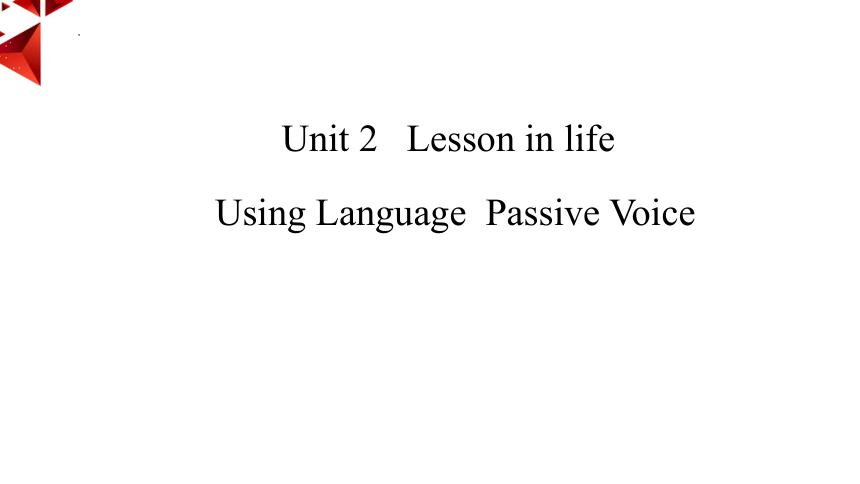 | |
| 格式 | zip | ||
| 文件大小 | 2.8MB | ||
| 资源类型 | 教案 | ||
| 版本资源 | 外研版(2019) | ||
| 科目 | 英语 | ||
| 更新时间 | 2022-04-24 18:35:17 | ||
图片预览

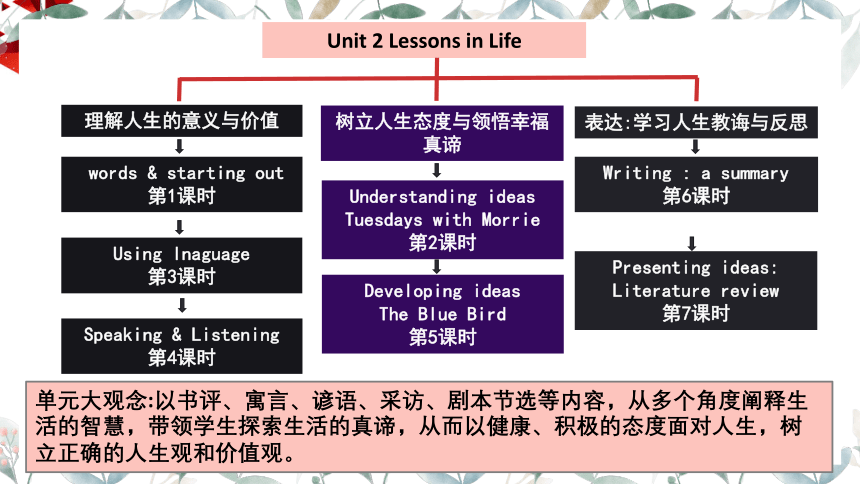

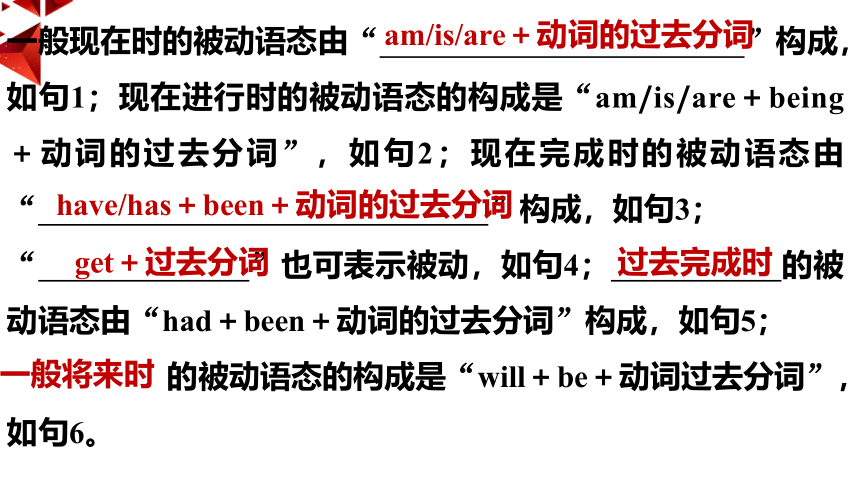
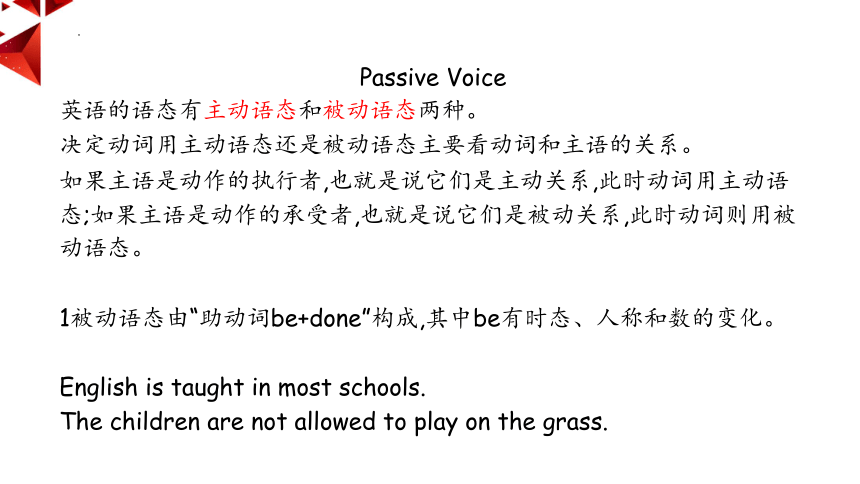
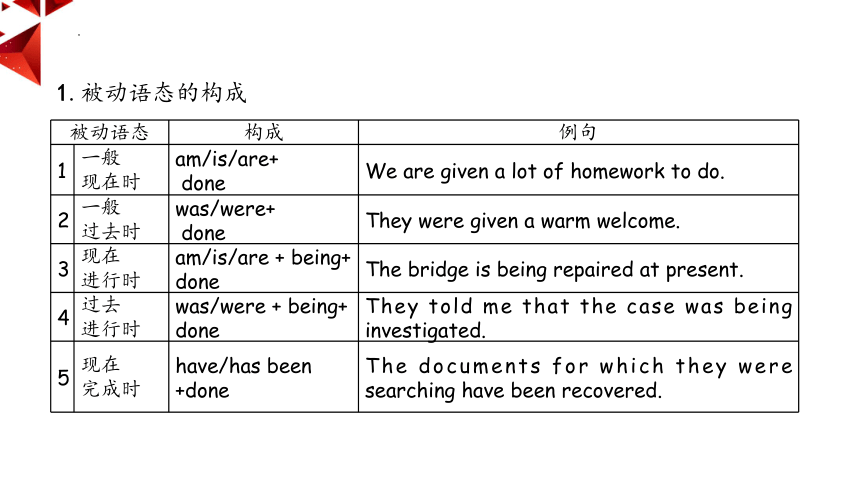
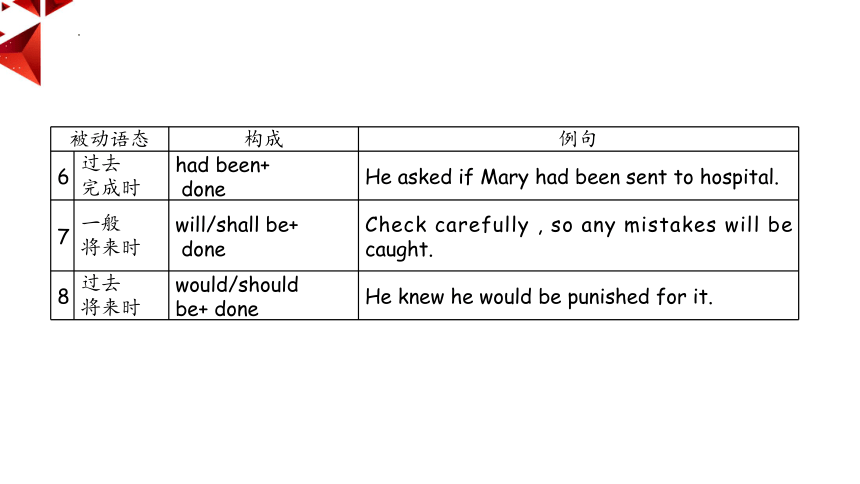
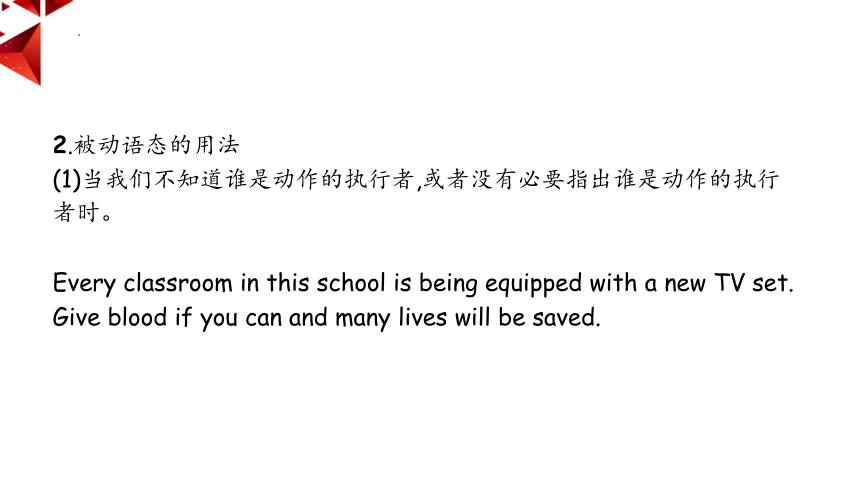
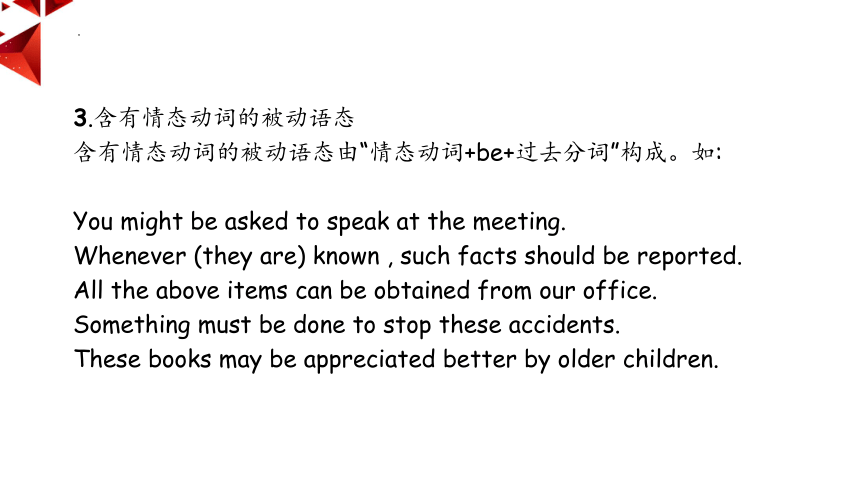
文档简介
(共25张PPT)
Unit 2 Lesson in life
Using Language Passive Voice
Unit 2 Lessons in Life
理解人生的意义与价值
树立人生态度与领悟幸福真谛
表达:学习人生教诲与反思
words & starting out
第1课时
Using lnaguage
第3课时
Speaking & Listening
第4课时
Understanding ideas
Tuesdays with Morrie
第2课时
Developing ideas
The Blue Bird
第5课时
Writing : a summary
第6课时
Presenting ideas: Literature review
第7课时
单元大观念:以书评、寓言、谚语、采访、剧本节选等内容,从多个角度阐释生活的智慧,带领学生探索生活的真谛,从而以健康、积极的态度面对人生,树立正确的人生观和价值观。
感知以下课文原句,补全方框下的小题
语法感知
语 法 导 学
感悟规律 重点难点剖析
1.This all changes when he is reunited with his favourite college professor,Morrie Schwartz.
2.On discovering that Morrie is being weakened by a severe illness...
3.After finishing it,I feel I have been given a deeper insight into the world and can see things from a different point of view.
4.While we are living,we tend to get distracted by unimportant things,such as gathering material possessions.
5.Reading this book made me feel as if I’d been woken up from a long sleep...
6.A box of tissues will be needed to get through this book!
一般现在时的被动语态由“ ”构成,如句1;现在进行时的被动语态的构成是“am/is/are+being+动词的过去分词”,如句2;现在完成时的被动语态由“ ”构成,如句3;
“ ”也可表示被动,如句4; 的被动语态由“had+been+动词的过去分词”构成,如句5;
的被动语态的构成是“will+be+动词过去分词”,如句6。
am/is/are+动词的过去分词
have/has+been+动词的过去分词
get+过去分词
过去完成时
一般将来时
Passive Voice
英语的语态有主动语态和被动语态两种。
决定动词用主动语态还是被动语态主要看动词和主语的关系。
如果主语是动作的执行者,也就是说它们是主动关系,此时动词用主动语态;如果主语是动作的承受者,也就是说它们是被动关系,此时动词则用被动语态。
1被动语态由“助动词be+done”构成,其中be有时态、人称和数的变化。
English is taught in most schools.
The children are not allowed to play on the grass.
1.被动语态的构成
被动语态 构成 例句
1 一般 现在时 am/is/are+ done We are given a lot of homework to do.
2 一般 过去时 was/were+ done They were given a warm welcome.
3 现在 进行时 am/is/are + being+ done The bridge is being repaired at present.
4 过去 进行时 was/were + being+ done They told me that the case was being investigated.
5 现在 完成时 have/has been +done The documents for which they were searching have been recovered.
被动语态 构成 例句
6 过去 完成时 had been+ done He asked if Mary had been sent to hospital.
7 一般 将来时 will/shall be+ done Check carefully , so any mistakes will be caught.
8 过去 将来时 would/should be+ done He knew he would be punished for it.
2.被动语态的用法
(1)当我们不知道谁是动作的执行者,或者没有必要指出谁是动作的执行者时。
Every classroom in this school is being equipped with a new TV set.
Give blood if you can and many lives will be saved.
3.含有情态动词的被动语态
含有情态动词的被动语态由“情态动词+be+过去分词”构成。如:
You might be asked to speak at the meeting.
Whenever (they are) known , such facts should be reported.
All the above items can be obtained from our office.
Something must be done to stop these accidents.
These books may be appreciated better by older children.
(2)为了强调动作的承受者时。
Visitors are requested not to touch the exhibits.
(3)出于策略、委婉、礼貌等不提出动作的执行者时。
You are said to be active recently.
It is reported that they will come to our city for a visit.
4.短语动词的被动语态
“动词+介词或副词”构成的短语动词,以及“动词+名词+介词”构成的短语动词,在被动语态中不要漏掉后面的介词或副词。如:
A man who is much talked about is always very attractive.
Many interesting experiments are carried out in our laboratory.
5.关于“get+过去分词”
在英语口语中,有时可用“get+过去分词”构成被动语态。如:
I got dressed as quickly as I could.我尽快穿上衣服。
I wasn’t surprised she got elected after all the efforts she had made.
We got delayed because of the holiday traffic.
I tried to find my way round London without a map and got lost.
注:“get+过去分词”这种结构比较常见的搭配有
get arrested、get caught、get confused、get delayed、get divorced、get dressed、get drowned、get drunk、get elected、get engaged、get hit、get killed、get lost、get married、get stuck等。
6.主动形式表示被动意义
(1)有些系动词,如:taste、sound、prove、feel、look、smell、remain、appear等本身含有被动意义。
They often eat in that restaurant because the food there tastes delicious.
What he said at the meeting proved true.
(2)表示主语的某种属性特征的动词,如:read、write、sell、open、shut、begin、wash、wear、cut、lock、play、drive等。这类动词后面常接一个修饰语。
The coat dries easily.
Books of this kind sell well.
将下列句子变为被动语态
1.In the near future , scientists will make more advances in the robot technology.
→In the near future , more advances in the robot technology
by scientists.
答案:will be made
2.You’ve failed to do what the teacher expected you to and I’m afraid the teacher will blame you.
→You’ve failed to do what you to and I’m afraid the teacher will blame you.
答案:were expected
3.After school we went to the reading-room to do some reading , only to be told that the workers were decorating it.
→After school we went to the reading-room to do some reading , only to be told that it .
答案:was being decorated
4.A lot of people often forget that the experts design oral exams to test our communicative ability.
→A lot of people often forget that oral exams to test our communicative ability.
答案:are designed
5.In the spoken English of some areas in the US , people often drop the “r” sound at the end of the words.
→In the spoken English of some areas in the US , the “r” sounds at the end of the words often .
答案:are ; dropped
完成句子
1.Don’t worry . The hard work that you do now (得到回报) later in life.
答案:will be repaid
2.They are living with their parents for the moment because their own house (正在重建).
答案:is being rebuilt
3.I’m calling about the apartment which (登广告的) the other day . Could you tell me more about it
答案:was advertised
4.Shakespeare’s play Hamlet (被制作成) into at least ten different films over the past years.
答案:has been made
5.We are confident that the environment (将会得到改善) by our further efforts to reduce pollution.
答案:will be improved
Rewrite the paragraph using the passive voice where appropriate.
Since ancient times, storytelling has been a way to share and pass on wisdom. One important early work that did so was Aesop’s Fables, a collection of stories that history credits to Aesop, a Greek storyteller. People believe that he lived in Ancient Greece between 620 BC and 564 BC. Most of the characters in his stories are animals, the qualities of which Aesop used to reflect human traits and wisdom. Each fable teaches a life lesson that Aesop summarises in a short phrase at the end of the story, called a moral. Today, children and adults all around the world still enjoy Aesop’s Fables.
Since ancient times, storytelling has been a way to share and pass down wisdom through generations. One important early work that did just this was Aesop’s Fables, a collection of stories that was credited to Aesop, a Greek storyteller. It is believed that Aesop lived in Ancient Greece between 620 BC and 564 BC. Most of the characters in his stories are animals, the qualities of which were used to reflect human traits and wisdom by Aesop. Each fable teaches a life lesson that is summarised in a short phrase at the end of the story, called a moral Today, Aesop’s Fables are still enjoyed today by children and adults all around the world.
One day a little mouse was caught by a lion...
Look at the pictures and write the story from Aesop’s Fables. Use the passive voice where appropriate.
One day a little mouse was caught by a lion. The lion wanted to eat the mouse, but the mouse said that he would help the lion someday, if he was let go. The lion thought, “How can a great animal be helped by a little animal ” But the mouse was allowed to leave. Several days later, the lion was caught by the hunter’s net. The mouse bit the net with his strong teeth and helped the lion out. Thanks to the little mouse, the lion was saved and finally admitted that the strong could sometimes be helped by the weak.
Complete the boxes with the expressions from the interview.
I started … back
in…
After that I …
But then five years
ago, …
I felt … at first.
I suggest that …
Remember …
Talking about experiences
I started… back in…
After that I…
But then five years ago…
I felt… at first.
Talking about experiences
Giving advice
Giving advice
I suggest that…
Remember, …
Self-evaluation
Can I use new words correctly
What can I do after this lesson
What is passive vioce
Unit 2 Lesson in life
Using Language Passive Voice
Unit 2 Lessons in Life
理解人生的意义与价值
树立人生态度与领悟幸福真谛
表达:学习人生教诲与反思
words & starting out
第1课时
Using lnaguage
第3课时
Speaking & Listening
第4课时
Understanding ideas
Tuesdays with Morrie
第2课时
Developing ideas
The Blue Bird
第5课时
Writing : a summary
第6课时
Presenting ideas: Literature review
第7课时
单元大观念:以书评、寓言、谚语、采访、剧本节选等内容,从多个角度阐释生活的智慧,带领学生探索生活的真谛,从而以健康、积极的态度面对人生,树立正确的人生观和价值观。
感知以下课文原句,补全方框下的小题
语法感知
语 法 导 学
感悟规律 重点难点剖析
1.This all changes when he is reunited with his favourite college professor,Morrie Schwartz.
2.On discovering that Morrie is being weakened by a severe illness...
3.After finishing it,I feel I have been given a deeper insight into the world and can see things from a different point of view.
4.While we are living,we tend to get distracted by unimportant things,such as gathering material possessions.
5.Reading this book made me feel as if I’d been woken up from a long sleep...
6.A box of tissues will be needed to get through this book!
一般现在时的被动语态由“ ”构成,如句1;现在进行时的被动语态的构成是“am/is/are+being+动词的过去分词”,如句2;现在完成时的被动语态由“ ”构成,如句3;
“ ”也可表示被动,如句4; 的被动语态由“had+been+动词的过去分词”构成,如句5;
的被动语态的构成是“will+be+动词过去分词”,如句6。
am/is/are+动词的过去分词
have/has+been+动词的过去分词
get+过去分词
过去完成时
一般将来时
Passive Voice
英语的语态有主动语态和被动语态两种。
决定动词用主动语态还是被动语态主要看动词和主语的关系。
如果主语是动作的执行者,也就是说它们是主动关系,此时动词用主动语态;如果主语是动作的承受者,也就是说它们是被动关系,此时动词则用被动语态。
1被动语态由“助动词be+done”构成,其中be有时态、人称和数的变化。
English is taught in most schools.
The children are not allowed to play on the grass.
1.被动语态的构成
被动语态 构成 例句
1 一般 现在时 am/is/are+ done We are given a lot of homework to do.
2 一般 过去时 was/were+ done They were given a warm welcome.
3 现在 进行时 am/is/are + being+ done The bridge is being repaired at present.
4 过去 进行时 was/were + being+ done They told me that the case was being investigated.
5 现在 完成时 have/has been +done The documents for which they were searching have been recovered.
被动语态 构成 例句
6 过去 完成时 had been+ done He asked if Mary had been sent to hospital.
7 一般 将来时 will/shall be+ done Check carefully , so any mistakes will be caught.
8 过去 将来时 would/should be+ done He knew he would be punished for it.
2.被动语态的用法
(1)当我们不知道谁是动作的执行者,或者没有必要指出谁是动作的执行者时。
Every classroom in this school is being equipped with a new TV set.
Give blood if you can and many lives will be saved.
3.含有情态动词的被动语态
含有情态动词的被动语态由“情态动词+be+过去分词”构成。如:
You might be asked to speak at the meeting.
Whenever (they are) known , such facts should be reported.
All the above items can be obtained from our office.
Something must be done to stop these accidents.
These books may be appreciated better by older children.
(2)为了强调动作的承受者时。
Visitors are requested not to touch the exhibits.
(3)出于策略、委婉、礼貌等不提出动作的执行者时。
You are said to be active recently.
It is reported that they will come to our city for a visit.
4.短语动词的被动语态
“动词+介词或副词”构成的短语动词,以及“动词+名词+介词”构成的短语动词,在被动语态中不要漏掉后面的介词或副词。如:
A man who is much talked about is always very attractive.
Many interesting experiments are carried out in our laboratory.
5.关于“get+过去分词”
在英语口语中,有时可用“get+过去分词”构成被动语态。如:
I got dressed as quickly as I could.我尽快穿上衣服。
I wasn’t surprised she got elected after all the efforts she had made.
We got delayed because of the holiday traffic.
I tried to find my way round London without a map and got lost.
注:“get+过去分词”这种结构比较常见的搭配有
get arrested、get caught、get confused、get delayed、get divorced、get dressed、get drowned、get drunk、get elected、get engaged、get hit、get killed、get lost、get married、get stuck等。
6.主动形式表示被动意义
(1)有些系动词,如:taste、sound、prove、feel、look、smell、remain、appear等本身含有被动意义。
They often eat in that restaurant because the food there tastes delicious.
What he said at the meeting proved true.
(2)表示主语的某种属性特征的动词,如:read、write、sell、open、shut、begin、wash、wear、cut、lock、play、drive等。这类动词后面常接一个修饰语。
The coat dries easily.
Books of this kind sell well.
将下列句子变为被动语态
1.In the near future , scientists will make more advances in the robot technology.
→In the near future , more advances in the robot technology
by scientists.
答案:will be made
2.You’ve failed to do what the teacher expected you to and I’m afraid the teacher will blame you.
→You’ve failed to do what you to and I’m afraid the teacher will blame you.
答案:were expected
3.After school we went to the reading-room to do some reading , only to be told that the workers were decorating it.
→After school we went to the reading-room to do some reading , only to be told that it .
答案:was being decorated
4.A lot of people often forget that the experts design oral exams to test our communicative ability.
→A lot of people often forget that oral exams to test our communicative ability.
答案:are designed
5.In the spoken English of some areas in the US , people often drop the “r” sound at the end of the words.
→In the spoken English of some areas in the US , the “r” sounds at the end of the words often .
答案:are ; dropped
完成句子
1.Don’t worry . The hard work that you do now (得到回报) later in life.
答案:will be repaid
2.They are living with their parents for the moment because their own house (正在重建).
答案:is being rebuilt
3.I’m calling about the apartment which (登广告的) the other day . Could you tell me more about it
答案:was advertised
4.Shakespeare’s play Hamlet (被制作成) into at least ten different films over the past years.
答案:has been made
5.We are confident that the environment (将会得到改善) by our further efforts to reduce pollution.
答案:will be improved
Rewrite the paragraph using the passive voice where appropriate.
Since ancient times, storytelling has been a way to share and pass on wisdom. One important early work that did so was Aesop’s Fables, a collection of stories that history credits to Aesop, a Greek storyteller. People believe that he lived in Ancient Greece between 620 BC and 564 BC. Most of the characters in his stories are animals, the qualities of which Aesop used to reflect human traits and wisdom. Each fable teaches a life lesson that Aesop summarises in a short phrase at the end of the story, called a moral. Today, children and adults all around the world still enjoy Aesop’s Fables.
Since ancient times, storytelling has been a way to share and pass down wisdom through generations. One important early work that did just this was Aesop’s Fables, a collection of stories that was credited to Aesop, a Greek storyteller. It is believed that Aesop lived in Ancient Greece between 620 BC and 564 BC. Most of the characters in his stories are animals, the qualities of which were used to reflect human traits and wisdom by Aesop. Each fable teaches a life lesson that is summarised in a short phrase at the end of the story, called a moral Today, Aesop’s Fables are still enjoyed today by children and adults all around the world.
One day a little mouse was caught by a lion...
Look at the pictures and write the story from Aesop’s Fables. Use the passive voice where appropriate.
One day a little mouse was caught by a lion. The lion wanted to eat the mouse, but the mouse said that he would help the lion someday, if he was let go. The lion thought, “How can a great animal be helped by a little animal ” But the mouse was allowed to leave. Several days later, the lion was caught by the hunter’s net. The mouse bit the net with his strong teeth and helped the lion out. Thanks to the little mouse, the lion was saved and finally admitted that the strong could sometimes be helped by the weak.
Complete the boxes with the expressions from the interview.
I started … back
in…
After that I …
But then five years
ago, …
I felt … at first.
I suggest that …
Remember …
Talking about experiences
I started… back in…
After that I…
But then five years ago…
I felt… at first.
Talking about experiences
Giving advice
Giving advice
I suggest that…
Remember, …
Self-evaluation
Can I use new words correctly
What can I do after this lesson
What is passive vioce
